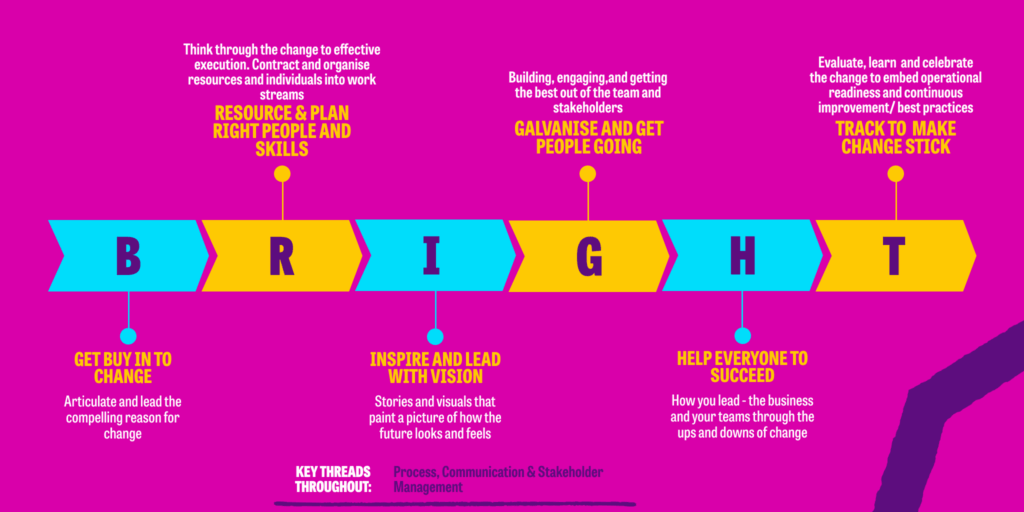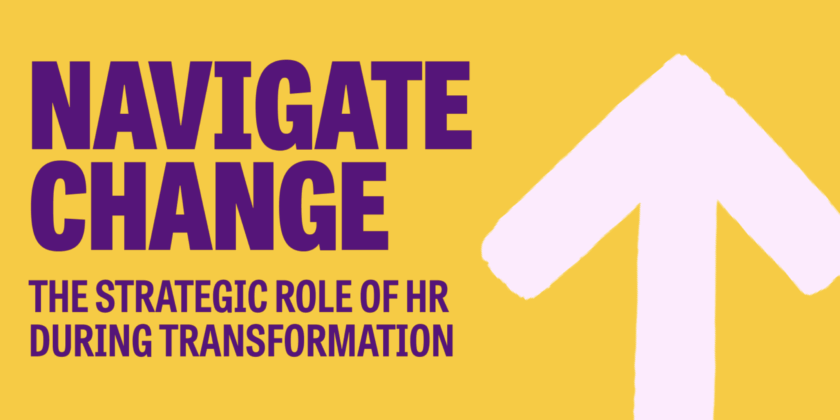A staggering 70% of change initiatives fail to achieve their goals. The most common reason? They forget the human element.
The convergence of hybrid teams, AI acceleration, changing employee expectations and economic volatility has created a perfect storm, pulling focus away from our people.
At a recent Let’s Talk Talent webinar, Debbie Venables spoke about how this has resulted in a leadership inflection point. It’s clear these challenges are here to stay, and an era of constant business evolution is the new norm.
For leaders steering their organisations through complex changes like restructures, mergers and digital shifts, the need for strategic HR leadership has never been more critical. This guide highlights how you can evolve HR from a support function to a strategic driver, shaping change strategy, maintaining engagement, and enabling resilience.
By embracing a human-centric, evidence-driven approach, you can maintain team alignment and performance during rapid change.
Why HR is a Strategic Partner During Change
During any significant organisational change, HR’s role is pivotal. The function acts as a strategic partner, ensuring that your workforce’s capabilities, company culture, and business goals are fully aligned with the transformation initiative.
This alignment is a key differentiator. Research from Betterworks shows that organisations with proactive, HR-driven change management report tangible benefits, including higher staff retention, better productivity, and faster adaptation to new operating models.
To achieve this, the skills required of your HR team are evolving. The focus has shifted from traditional administrative duties to proactive, strategic responsibilities that directly influence business outcomes.
The Future Skillset for Strategic HR
For your HR function to be a true partner, it must move beyond process-oriented tasks to develop these impact-oriented skills:
- Data Analytics and Storytelling: It’s about translating complex analytics into a compelling narrative that influences executive decisions and demonstrates a clear return on investment.
- Business and Financial Acumen: Your HR leaders must understand the company’s financial health, market position, and operational challenges. By speaking the language of the C-suite, they can design people strategies – from compensation to talent acquisition – that directly support your financial targets.
- Digital Fluency and AI Integration: In the modern workplace, HR must lead the conversation on digital transformation from a people perspective. This means understanding how to leverage technology and AI to enhance recruitment, engagement and skills development, ensuring technology augments your team’s capabilities and aligns with your company culture.
- Strategic Workforce Planning: This involves proactively shaping your workforce for the future, not just filling today’s open roles. Your HR team should be forecasting long-term talent needs, identifying skills gaps, and designing an organisational structure that ensures you have the right people to achieve your strategic objectives.
The difference is a fundamental shift from a reactive support function to a proactive driver of business growth. While traditional HR ensures your organisation runs smoothly today, a strategic HR partner ensures it has the talent, structure, and culture to win in the future. Success depends on implementing the right change management approach for your business.
Models & Methods for Change Management
To structure a major transformation, leaders often turn to established change management models. While many exist, the best practice is to combine frameworks to fit your organisation’s unique context. To be effective, you must adapt these models to fit your organisation’s unique culture, as a one-size-fits-all approach rarely succeeds. Understanding the key features of different models will help you support your journey.
The most common models include:
| Model | Key Threads and Overview |
|---|---|
| Lewin’s Change Management Model | Use Lewin’s Model for straightforward, top-down changes that can be broken down into a clear process. Its three stages – Unfreeze, Change, and Refreeze – make it a simple, logical framework for planned projects where the end state is well-defined. It’s most effective for managing the organisational process, rather than individual transitions. |
| ADKAR Model | The ADKAR Model is best when success depends heavily on individual adoption. It focuses on five outcomes each person must achieve – Awareness, Desire, Knowledge, Ability, and Reinforcement – making it ideal for new technology rollouts or process changes. It helps you pinpoint where employees are getting stuck and provides targeted support. |
| Bridges’ Transition Model | Use Bridges’ Transition Model for changes with a significant psychological and emotional impact, such as mergers or restructures. The model focuses on the human side of change, guiding leaders to manage three stages: Ending, The Neutral Zone, and The New Beginning. Its primary strength is in helping employees let go of the old way and embrace the new. |
While these models provide a theoretical foundation, effective execution requires a practical, step-by-step framework. That’s why we created the BRIGHT model, to turn theory into action.
From Resistance to Resilience: HR’s Practical Tools
To move your teams from resistance to resilience, you need practical, actionable tools. Rather than relying on generic models alone, a structured, people-first framework can drive engagement and build momentum.
At Let’s Talk Talent, we use the BRIGHT model to guide leaders through the six critical steps of leading change effectively. These steps are underpinned by the key threads of Process, Communication, and Stakeholder Management. The toolkit gives you the critical questions you need to ask to achieve the desired impact.
Applying practical frameworks like BRIGHT through people-driven resources like our Change Management and Transformation Workshops can significantly improve capability and resilience.

Continuous Learning and Internal Mobility
Embedding change requires a long-term vision. HR can fuel this by creating a focus on driving continuous learning and internal mobility.
During times of change, your HR team must lead the development of upskilling and reskilling initiatives. Championing internal mobility not only retains valuable talent, but also leverages institutional knowledge as a growth engine, ensuring the organisation has the right skills to thrive post-transformation.
For example, we are partnering with a client in the education sector to drive adoption from the top down. Their leaders now dedicate one day a week to actively participating in the transformation. This ensures employees see the change as a shared journey, not just another top-down process, exponentially increasing the chance of realising value from the investment.
Making it Real: Fuelling a Scale-Up’s Growth by Fixing its Leadership Gap – A Client Story
To illustrate how a people-first approach works in practice, consider a recent client story.
- The Challenge: The managers, while technically skilled, lacked formal people management experience. This led to inconsistent standards, ‘safe communication’, and a potential bottleneck to growth.
- The Solution: We collaborated with the client to build new performance management and competency frameworks, creating a unified standard for success. We engaged a third of the company through workshops to secure buy-in and make the concepts memorable.
- The Transformation: The initiative equipped managers with the confidence and tools for quality conversations. It aligned the entire company for its first structured review cycle and fostered a culture of clarity and trust to fuel future growth.
The Future is Bright
In today’s landscape, navigating change is no longer a one-off project – it’s the new normal. Successfully leading a transformation requires more than just a model; it demands a strategic, human-centric approach that turns resistance into resilience.
As we’ve explored, shifting HR from a support function to a strategic driver is the key to aligning your people with your goals. But theory alone won’t get you there. You need a practical framework and an expert partner to make it real.
How Can We Help You Build Your Roadmap?
At Let’s Talk Talent, we don’t just talk about change, we partner with you to build the roadmaps that make it happen. Using proven, people-first tools like our BRIGHT model, helps organisations move beyond the chaos. We help you build the engagement, capability, and clarity your teams need to not only survive transformation, but to drive it and thrive.
We empower your leaders and teams through practical, tailored solutions designed to deliver results:
- Management & Leadership Development: Custom programmes that equip your leaders with the skills to build ‘change fitness’ across the organisation.
- Leadership Assessments: Powerful tools to help leaders tap into their authentic styles and build more effective, collaborative teams.
- Change Management Workshops: Interactive sessions designed to create a shared purpose and a practical roadmap for successful transformation.
- Learning & Development Solutions: Future-focused learning that builds the critical, transferable skills your teams will need for tomorrow.
- Executive Coaching: Personalised support to empower your leaders, helping them confidently navigate the shift from theory to action.
Ready to Get Started?
If so, schedule a complimentary discovery call with our team: Contact us, or email us at info@letstalktalent.co.uk.
And for ongoing insights on leadership, talent, and transformation, subscribe to our HR Hot Takes LinkedIn newsletter here.
